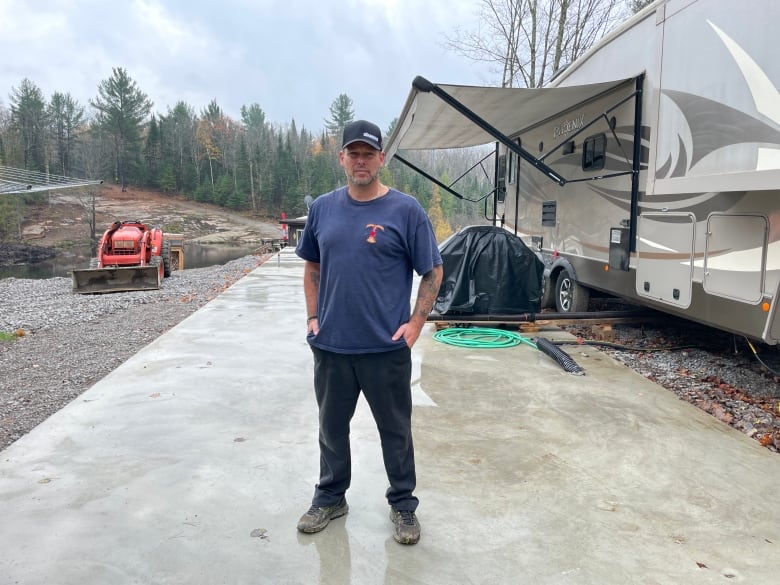Dealing with sky-high connection charges, rural Ontarians go off the grid
[ad_1]
When Craig Timmermans got down to construct a brand new headquarters for his firms in northern Ontario, he reached out to the ability firm to learn the way a lot it could cost him to hook up with the grid.
He says he anticipated to pay a number of thousand {dollars}, on condition that the closest pole was throughout the road, about 45 metres away. He was shocked to search out out it could value $80,000.
“I believed that was simply completely outrageous,” Timmermans instructed CBC Information.
Hydro One, which distributes electrical energy for many rural clients within the province, ultimately lowered the associated fee to $25,000. It was nonetheless an excessive amount of, in keeping with Timmermans.
“After which on prime of that, to pay, , an electrical invoice, in all probability at round 4 to 5 hundred {dollars} a month for the remainder of my life and solely growing. I believed, properly, now’s the time to go off-grid.”
Final summer time, Timmermans’s two radio stations: Nice Lakes Nation 103.1 and Hits 100.7 went dwell from their new residence — in Little Present, Ont., about 90 kilometres southwest of Sudbury — the primary off-grid stations in Canada.

They, together with the web service supplier Timmermans additionally owns, are powered by 24 photo voltaic panels and a wind turbine.
Mixed, the system produces eight kilowatt hours — greater than sufficient to run his workplaces, radio studios, the central air con and the servers that preserve his web clients linked 12 months ‘spherical, he says.
It value him $23,000.
“However on prime of that, we’ve no extra [power] payments after that,” Timmermans stated.
In winter, he says he wants a propane furnace to warmth the constructing.
A separate wind-and-solar array principally powers the stations’ transmitters, which belt out 77,500 watts of radio sign as far south because the Bruce Peninsula. The remainder comes from the normal energy grid, however not for lengthy, Timmermans hopes.

Powering the transmitters used to value a small fortune: $6,000 a month, he says.
“Our present fee is about $1,500,” he instructed CBC Information.
“With extra photo voltaic panels that we’re putting in at the moment, I hope to carry that invoice down nearer to zero and we’ll principally use Hydro One as a backup. And so what that principally means is financial savings of $6,000. That is one other worker that we’ll rent.”
Timmermans is considered one of a variety of rural Ontarians who, delay by excessive connection prices, have left the grid in favour of renewable energies.
“The price of photo voltaic and battery storage techniques have each decreased by roughly 90 per cent since 2010,” stated Nicholas Gall of the Canadian Renewable Power Affiliation.
“Right this moment a photo voltaic and battery storage system that will allow a house owner to be fully self-sufficient may very well be obtained for as little as $50,000, absolutely put in.”

Gall says there aren’t any statistics on what number of Canadians are going off grid, however says it is simpler than ever.
“Along with avoiding rising utility prices, going off-grid might be an interesting choice for householders in search of to scale back their environmental footprint, and to offer larger resiliency from blackouts attributable to excessive climate occasions, that are prone to improve because of local weather change.”
However there are advantages to being on the grid, says Teresa Sarkesion, president and CEO of Ontario’s Electrical Distribution Affiliation.
“Reliability is a prime precedence for Ontario’s electrical energy clients and that could be a key advantage of being linked to the grid along with peace of thoughts and worth for cash,” she stated in a press release.
Chris Hartwell additionally pulled the plug after studying a connection for his new residence close to Minden — a city 193 kilometres northeast of Toronto, in Ontario’s cottage nation — would value at the very least $80,000.
“They type of gave me no different choice however to go off-grid,” stated the 49-year-old veteran.
The provincial regulator requires clients who purchase properties not hooked as much as the electrical energy system to pay the associated fee of connecting, in keeping with a spokesperson for Hydro One.
The corporate serves about about 1.5 million principally rural clients, and provides about 18,000 buyer connections per 12 months, in keeping with a spokesperson.
Hartwell’s property is on a 2.5-kilometre stretch of highway the place there is a hole within the energy traces. The closest pole to hook up with is about one kilometre away.
CBC News previously reported on his neighbour, Allan Robinson, who additionally lives inside that hole. Connecting his newly constructed residence would have value $60,000.
Hartwell is as a substitute placing in a photo voltaic system for $42,500 that’s anticipated to completely electrify his residence. A propane furnace will present warmth.
“I’ve no use for Hydro. I’ve no use for the payments anymore,” he stated.
[ad_2]
Source link



Post a Comment